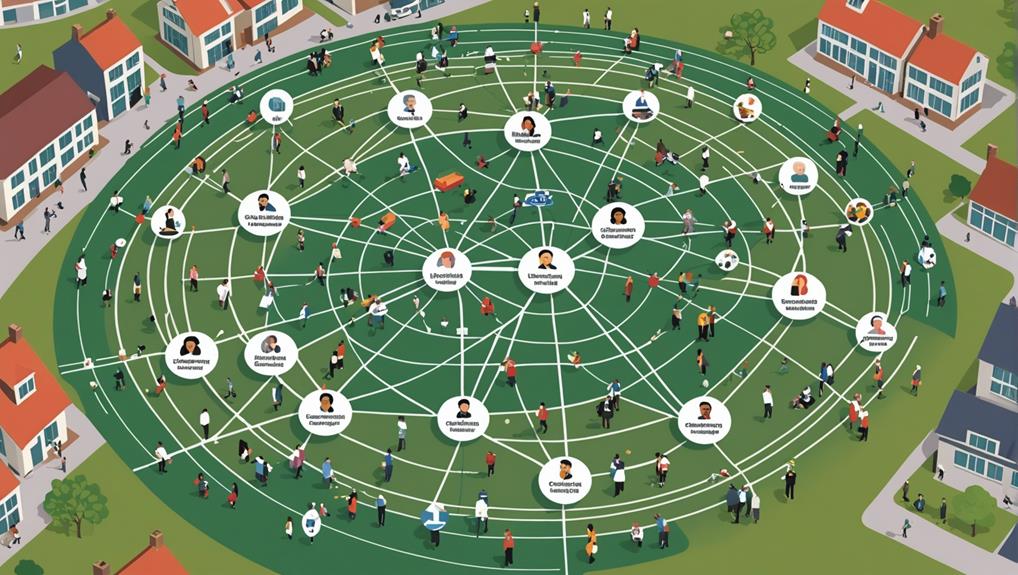The bustling town of Aylesbury is bracing itself for significant travel disruptions as a crucial thoroughfare into the town is […]
You're curious about Buckinghamshire's local government structure. To sum it up, it's a unitary authority, where one council governs the area, providing all local government services to residents. This council delivers essential services like education and waste management, while engaging with the community to understand diverse needs. Elected councillors represent community interests, making decisions through council meetings and committees. With 147 councillors serving four-year terms, the council guarantees transparency and accountability. As you explore further, you'll discover more about the council's roles, responsibilities, and relationships with stakeholders, shedding light on how this structure works to benefit the community.
Key Takeaways
• Buckinghamshire Council is a unitary authority governing the area, providing all local government services to residents.
• The council has a governance structure, outlined in its constitution, ensuring transparency in decision-making.
• 147 councillors, elected every four years, represent community interests, attend meetings, and engage with residents.
• The Cabinet makes key decisions on specific areas like finance and education, while Full Council meetings focus on major policies.
• Parish councils operate at the local level, addressing community needs, raising funds, and collaborating with higher-tier councils.
Buckinghamshire Council's Role
Buckinghamshire Council, a unitary authority, takes center stage in governing its area, providing all local government services to its residents. As you explore the local government structure, you'll find that the council plays a crucial role in delivering essential services, from education to waste management. This all-encompassing approach to service delivery guarantees that residents receive a wide range of services, catering to their diverse needs.
As a key player in the community, Buckinghamshire Council prioritizes community engagement, fostering strong relationships with residents, businesses, and local organizations. By doing so, the council stays attuned to the community's needs, allowing it to tailor its services and policies to meet the unique demands of the area. This collaborative approach enables the council to respond effectively to local challenges, promoting a sense of community and social cohesion.
Decision-Making Process Explained
As you explore the intricacies of Buckinghamshire's local government, understanding how decisions are made is essential, and it all starts with the council's elected representatives. These representatives, chosen by the community, play a pivotal role in shaping the council's decision-making process.
Here are the key steps involved in the decision-making process:
- Elected councillors represent the community's interests and voice concerns.
- Council meetings provide a platform for discussion and debate.
- Full Council meetings focus on major policies and decisions affecting the community.
- The Cabinet makes key decisions on specific areas, such as finance, education, or health.
Transparency is fundamental in Buckinghamshire Council's decision-making process. The council's constitution outlines governance structure, roles, responsibilities, and decision-making rules, ensuring that community engagement and public consultation are integral parts of the process.
Councillors and Their Responsibilities

With 147 councillors representing the community, you can expect a diverse range of perspectives and expertise shaping the council's decision-making process. These councillors come from various political affiliations, ensuring that different viewpoints are considered when making decisions.
As elected representatives, their duties include attending council meetings, participating in committees, and engaging with local residents to understand their concerns. They must also adhere to the council's code of conduct and decision-making rules outlined in the constitution.
It's worth noting that all councillors are elected for a four-year term, with the next election scheduled for 2025. You can access a full list of councillors, along with details of their roles, privacy, and contact information on the council's website.
Local Governance Structure Breakdown
You're likely familiar with the concept of local government, but have you ever wondered how it's structured in Buckinghamshire? To break it down, Buckinghamshire's local government operates under a unitary authority system, with Buckinghamshire Council overseeing all local government services in the area.
Here's an overview of the governance structure:
- Council Meetings: Governed by specific rules and procedures, council meetings provide a platform for councillors to discuss and decide on various issues affecting the community.
- The Cabinet: A group of councillors selected by the leader, responsible for making key decisions, shaping policies, and planning strategies for the council.
- Governance Overview: The council's constitution outlines governance structures, decision-making processes, roles, and responsibilities of councillors, as well as rules for transparency and accountability.
- Community Engagement: Councillors, representing 49 wards, engage with the community to understand their needs and priorities, ensuring policy implementation and service delivery meet local demands.
This governance structure enables effective policy implementation and service delivery, ensuring that the needs of the community are met. By understanding how local government is structured, you can better appreciate the role of councillors and the council in shaping the future of Buckinghamshire.
Elections and Electoral Cycles

Every four years, Buckinghamshire's electorate heads to the polls to shape the council's direction, electing 147 councillors who'll represent the 49 wards and make key decisions affecting the community.
As you cast your vote, you're contributing to the democratic process that determines the council's trajectory. The regular electoral cycle guarantees that councillors are held accountable for their actions and are responsive to your needs. This, in turn, fosters community engagement and encourages voter turnout.
The term limits for councillors also promote accountability, preventing any one individual from holding too much power for too long. This system allows for fresh perspectives and ideas to emerge, keeping the council dynamic and representative of the community's evolving needs.
Parish Councils and Their Function
As you've seen the impact of council decisions on the community, let's explore the role of parish councils, which operate at the most local level of government, addressing specific community needs and concerns. These councils play an essential role in local governance and service delivery, representing specific communities within the county. They've the authority to make decisions on local issues such as planning applications and community facilities.
Here are some key aspects of parish councils' functions:
- Funding sources: Parish councils can raise their own funds through the council tax, grants, and other sources to support community projects.
- Community projects: They initiate and support community projects, such as improving local amenities, enhancing community engagement, and providing a platform for residents to voice their concerns.
- Collaboration: Parish councils work closely with higher-tier councils like Buckinghamshire Council to address community needs effectively.
- Decision-making: They've the power to make decisions on local issues, ensuring that community needs are addressed in a timely and effective manner.
Council's Relationship With Stakeholders

By engaging with stakeholders through various mechanisms, Buckinghamshire Council guarantees that community voices are heard, fostering a collaborative environment that drives effective decision-making and service delivery.
As you explore the council's relationship with stakeholders, you'll notice that it's built on a foundation of stakeholder engagement and community involvement. Through public consultations, forums, and partnerships, the council actively engages with residents, businesses, community groups, and other local authorities.
This collaborative approach assures that stakeholder feedback and input shape policies, projects, and initiatives, addressing local needs and priorities efficiently. By valuing stakeholder input, the council creates an environment where community voices are heard, and concerns are addressed.
Regular communication and collaboration with stakeholders help the council make informed decisions, delivering services that meet the community's needs. By fostering strong relationships with stakeholders, Buckinghamshire Council demonstrates its commitment to community-driven governance, ensuring that everyone has a say in shaping the county's future.
Frequently Asked Questions
What Is the Local Authority for Buckinghamshire?
You're wondering what the local authority for Buckinghamshire is? Well, it's Buckinghamshire Council, a unitary authority with a rich council history, exercising authority powers to provide all local government services in the area.
How Is Local Government Structured?
You'll find that local government is structured as a unitary authority, ensuring transparency through a clear government hierarchy, where Buckinghamshire Council makes decisions, and the Cabinet plays a key role in shaping policy and strategy.
Who Runs Buckinghamshire Council?
You'll find that Buckinghamshire Council is run by 147 councillors, representing 49 wards, who hold committee roles and make up the council leadership, ensuring decision-making processes adhere to the council's constitution and code of conduct.
Is Buckinghamshire Council Labour or Conservative?
You're wondering if Buckinghamshire Council is Labour or Conservative? Currently, the council is controlled by the Conservative Party, reflecting the area's political leanings, with the Tories holding the majority of council seats.
Conclusion
Now that you've explored Buckinghamshire's local government structure, you've gained a deeper understanding of how decisions are made and implemented.
From the role of Buckinghamshire Council to the functions of parish councils, you've seen how each component works together to serve the community.
With this knowledge, you're better equipped to engage with local governance and make a positive impact in your area.